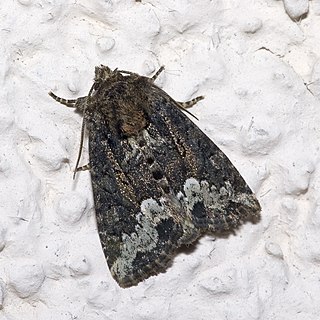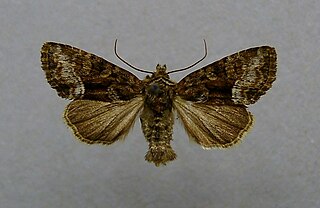
The large yellow underwing is a moth, the type species for the family Noctuidae. It is an abundant species throughout the Palearctic realm, one of the most common and most familiar moths of the region. In some years the species is highly migratory with large numbers appearing suddenly in marginal parts of the range.

The lesser yellow underwing is a moth of the family Noctuidae.

The lesser broad-bordered yellow underwing or Langmaid's yellow underwing is a moth of the family Noctuidae. It is distributed throughout southern and central Europe, and southern Sweden.

The copper underwing, humped green fruitworm or pyramidal green fruitworm is a moth of the family Noctuidae. The species was first described by Carl Linnaeus in his 1758 10th edition of Systema Naturae.

Svensson's copper underwing is a moth of the family Noctuidae. The species was first described by Charles E. Rungs in 1949. It is distributed throughout Europe including Russia east to the Urals.

The straw underwing is a species of moth in the family Noctuidae. The species was first described by Johann Siegfried Hufnagel in 1766. It is found from North Africa west through South Europe and Central Europe. In the north it is in parts of Ireland, Scotland, Sweden, Norway, Finland and Estonia. Further east the range stretches from southern Russia and Asia minor to the Caucasus.

The marbled minor is a moth of the family Noctuidae. The species was first described by Carl Linnaeus in his 1758 10th edition of Systema Naturae. It is distributed throughout Europe, east through the Palearctic to central Asia and the Altai Mountains. It rises to heights of over 1500 meters in the Alps.

Catocala is a generally Holarctic genus of moths in the family Erebidae. The genus was erected by Franz von Paula Schrank in 1802. The moths are commonly known as underwing moths or simply underwings. These terms are sometimes used for a few related moths, but usually – especially when used in plural, not as part of a species name – they are used to refer to Catocala only.

Noctua is a genus of moths. They have dull, cryptic forewings and often very bright hindwings. These are hidden under the forewings when the moths rest, leading to their common name of yellow underwings. They are not particularly closely related to the "true" underwing moths (Catocala) though, apart from both being Noctuoidea. They are good fliers.

Oligia latruncula, the tawny marbled minor, is a species of moth belonging to the family Noctuidae. The species was first described by Michael Denis and Ignaz Schiffermüller in 1775. It is distributed throughout Europe from northern Scotland and middle Fennoscandia in the north and then south to central Spain, Sicily and Greece. In the east, the species ranges to Western Asia. In the Alps it rises to an altitude of 2000 meters.

Oligia versicolor, the rufous minor, is a species of moth belonging to the family Noctuidae. The species was first described by Moritz Balthasar Borkhausen in 1792. It is distributed throughout Europe from Bulgaria up to the Caucasus in the south. In the north, it is found in southern Scotland, southern Sweden and Estonia through Europe to central Spain, southern Italy.

Orthosia populeti, the lead-coloured drab, is a moth of the family Noctuidae. It is found in Europe.

Orthosia miniosa, the blossom underwing, is a moth of the family Noctuidae. The species was first described by Michael Denis and Ignaz Schiffermüller in 1775. It is found in Europe.

Noctua interjecta, the least yellow underwing, is a species of moth of the family Noctuidae. It is found in Europe.

Mormo maura, the old lady or black underwing, is a species of moth of the family Noctuidae. The species was first described by Carl Linnaeus in the 10th edition of his Systema Naturae. It is found in the Palearctic realm, from north-western Africa through all over southern Europe. It reaches its northern border in the west in northern Ireland and central Scotland, in central Europe, in northern Germany and Poland. In some Nordic countries, there are single finds. The other occurrence areas include Turkestan, Anatolia, the Middle East and Iraq. The name "old lady" refers to the fact that the wing pattern was said to resemble the shawls worn by elderly Victorian ladies.

Mesoligia furuncula, the cloaked minor, is a moth of the family Noctuoidea. It is found in the Palearctic realm (Europe, northwest Africa, Russia, Siberia, Japan, north Iran, Afghanistan, and China.

Hoplodrina ambigua, the Vine's rustic, is a moth of the family Noctuidae. It is found in the western Palearctic realm.

Noctua fimbriata, the broad-bordered yellow underwing, is a moth of the family Noctuidae. It is found in Europe, North Africa, Anatolia, the Caucasus, Turkey, Caucasus, Transcaucasia, Armenia, Turkmenistan and Novosibirsk Oblast. The border of its southern range is unclear because of the similar looking species Noctua tirrenica.

Noctua orbona, the lunar yellow underwing, is a moth of the family Noctuoidea. It is found in the Palearctic.

Anarta myrtilli, the beautiful yellow underwing, is a moth in the family Noctuidae. The species was first described by Carl Linnaeus in 1761. It is found in most of Europe including Scandinavia, Britain, France, Germany, Switzerland, Spain, Portugal, Italy, and Russia.






















